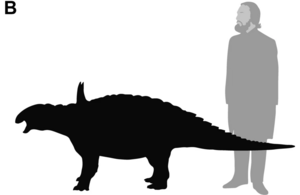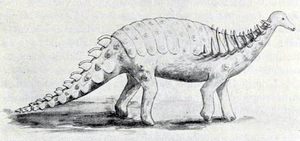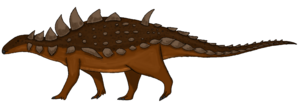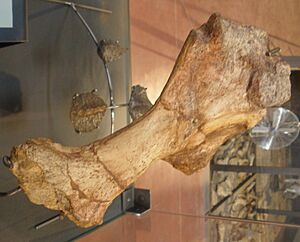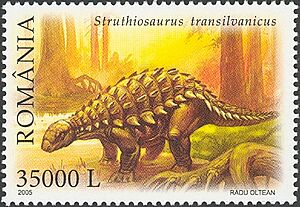Struthiosaurus facts for kids
Quick facts for kids Struthiosaurus |
|
|---|---|
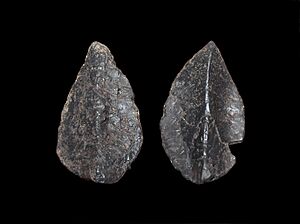 |
|
| Fossilized bony plates (osteoderms) of S. austriacus on display at a museum in Vienna. | |
| Scientific classification |
|
| Unrecognized taxon (fix): | Struthiosaurus |
| Type species | |
| †Struthiosaurus austriacus Bunzel, 1871
|
|
| Other species | |
|
|
| Synonyms | |
|
|
Struthiosaurus was a small, armored dinosaur that lived in Europe during the Late Cretaceous period, about 85 to 66 million years ago. Its name means "ostrich lizard," which comes from the Latin word struthio (ostrich) and the Greek word sauros (lizard).
This plant-eating dinosaur was about the size of a large pig, measuring 2 to 3 meters (about 6.5 to 10 feet) long. It was a type of nodosaurid, which means it was covered in bony plates and spikes for protection.
Contents
How Struthiosaurus Was Discovered
The story of Struthiosaurus begins in 1859 in a coal mine near Wiener Neustadt, Austria. A geologist named Eduard Suess found a strange tooth on a pile of rocks. He and the mine's manager searched for more fossils and found a layer of rock filled with bones.
The fossils were sent to the University of Vienna museum. In 1871, a scientist named Emanuel Bunzel studied them. He realized they belonged to a new type of dinosaur. He named it Struthiosaurus austriacus because he thought its skull bones looked similar to those of a bird, like an ostrich. The name austriacus refers to Austria, where it was found.
A Funny Mistake
When Bunzel first studied the fossils, he found some unusual rib bones. He thought they belonged to a giant lizard and even gave it a separate name: Danubiosaurus anceps. Later, scientists figured out that these ribs were actually from Struthiosaurus. Because this dinosaur's body was so flat, its ribs were shaped differently than expected.
What Did Struthiosaurus Look Like?
Struthiosaurus was a small but sturdy dinosaur that walked on four legs. Its main feature was its body armor, which was made of bony plates and spikes embedded in its skin. These plates are called osteoderms. This armor was its best defense against predators.
Unlike some of its more famous relatives, like Ankylosaurus, Struthiosaurus did not have a heavy club at the end of its tail. It was a plant-eater, or herbivore, likely feeding on low-growing plants.
Types of Struthiosaurus
Paleontologists have identified three main species of Struthiosaurus. They are all very similar, with only small differences in their skeletons.
- S. austriacus was found in Austria.
- S. transylvanicus was discovered in Romania. It was slightly larger than the Austrian species.
- S. languedocensis was found in France.
Family Tree and Relatives
Struthiosaurus is part of the Nodosauridae family, a group of armored dinosaurs. Nodosaurids are known for having protective armor but no tail clubs. Struthiosaurus is considered one of the more basic, or "primitive," members of this group. It was also one of the last known armored dinosaurs to live in Europe before the mass extinction event that wiped out the dinosaurs.
This family tree shows how the different Struthiosaurus species might be related to other armored dinosaurs.
| Struthiosaurini |
|
||||||||||||||||||||||||||||||
How Did Struthiosaurus Live?
Based on its skeleton, scientists believe Struthiosaurus was a slow-moving animal. A study of its fossilized brain case published in 2022 gave us some exciting clues about its life.
The study showed that Struthiosaurus had very poor hearing. This means it probably couldn't hear predators approaching from far away and had to rely on its armor for surprise attacks. The shape of its inner ear also suggests it was very sluggish and not very active. Scientists think it was a solitary animal, meaning it probably lived alone instead of in large groups or herds.
See also
- Timeline of ankylosaur research
- Cairanoolithus


